WORLD CLASS COACHING
40 Group and Tactical Defending Exercises
By Luca Bertolini
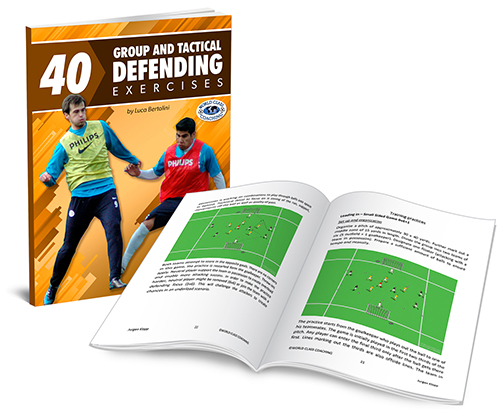
Table of Contents
PART ONE
Introduction
The Principles and Tactics of Team Defending
PART TWO
Defending With and Against the 4-3-3
Defending With and Against the 4-2-3-1
PART THREE
Defending With and Against the 4-4-2
PART FOUR
Defending With and Against the 3-5-2
Introduction: Team Defending
Team defense is a dance; the players are dancers who must learn the individual steps first (the individual soccer principles of play), then how to move in relation to the closer dancers (teammates and opponents - group defense) and, in the end, how to dance at the same rhythm of all the other teammates, with the right timing, toward the right spaces that are required by the game situation.
It is very important to understand how the principles of team defense (defense tactical principles) must always be respected and followed, whatever are the tactical developments or solutions that a team uses as pattern of play, to solve a game situation; it doesn't matter if a team uses man or zonal defense, with 3, 4 or 5 defenders, as these principles are the basis of the phase of play without possession.

The positioning of the team without possession is the prerequisite to develop all the other principles of defense. The team must make the pitch small to tighten the space for the opposition. Each player should be positioned both to counter an opponent and to cover a space or a teammate. This principle is valid among the players, as well as among the team sectors.
On the next two pages, we will show pictures of two different defensive positioning shapes.
The first picture shows a classic offensive team shape of Guardiola's Manchester City and consequently, the team shape during transitions to defense phases, as the possession is lost.
The players must be well skilled from an individual point of view to switch the attitude from possession to non-possession phase, but they must be correctly positioned to react as team to the transition to defense phase. For example: 6 advanced players to counter-press, 1 player to balance, 3 defenders to cover deep and protect the goalkeeper, who is placed out of the penalty area.
The type of players' positioning affects all the other defense principles of play that are independent from the tactical developments anyway.
The attacking positions determine the transition to defense phase of the team that loses the possession; but here again, the main principles of defense phase are the same.

When and how to press, when to drop off, when and how to counter, to create a strong area or side etc. are developments related to the game situation and to the positions of the ball and of the opponents.
This is an example of team shape after a tactical development, after a failed pressure attempt, as the opposing team has been able to progress forward and to develop a possession phase inside the middle and first third.
The principles of play in this situation are fixed, but how the team arrived at this shape is a consequence of tactical developments and game situations.
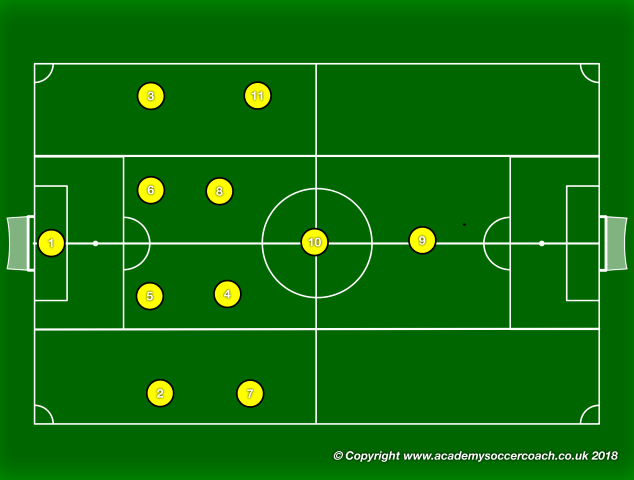
This example is a classic 1-4-4-2-defense shape, usually in front of the penalty area, whatever is the starting formation and further developments. These last seasons, beside the 3 man defense, the coaches have moved to a compact and organized flat back 4.
It is very important to work on covering space, not marking, away from the ball, and on getting support for the first defender near the ball, backing off instantly when the opponent passes the ball away. To cover the depth is then the first goal. 1 v 1 duels seem to be very important during pressure phases, but then the depth protection becomes fundamental if the opposition is able to progress forward.
Team principles of play
Balance: coordinated movements of the defending team from one area of the field to another one, as the ball is moved to that part, keeping the defensive active area (near and around the ball) balanced and paying attention to the weak side (away from the ball). The objective is to reorganize the defense in front of the ball.
Tracking: following opponents’ runs off the ball and of the player in possession when dribbling. For example, a defender chasing an attacking player who is making a forward and/or diagonal movement to generate a passing option in front of the ball.
Switching positions: the exchange of positions between 2 defenders in order to be more efficient defensively against cut, diagonal runs or overlapping combinations of the opponents. For example, a center back moves to the flank to defend the right-attacker and the left defender runs toward the center to cover the center back position, while retreating.
Zonal defending: the equal distribution of defenders into space to create defensive efficiency and to prevent the opposition from reaching the goal; every player should be aware of the assigned area of responsibility.
Team pressure: intense, constant and organized actions of a group of players against the opponents to create defending numerical advantage 2 v 1, or more, on the ball, and as unit in the final third, middle third or first third.
Retreat and recovery: movement of a group of players back toward defensive positions in order to reorganize the team’s defensive shape and to prevent the opposition from playing in behind the lines and at the back of the last defense line, when the pressure action is not effective.
Compactness/Concentration: create high density of players near the ball to force the opposition's possession phase backwards or toward the sidelines.
Direct the opponent: force the direction of the possession phase of the opposition (player, sector or team) toward easier areas to defend; generally outside or inside to create high density of players.
Delay: action of the defending team against the opposition to decrease the space of the offensive phase, restricting the passing options and preventing dribbling moves to progress through the field and toward the goal. The rhythm of play must be slowed down.
The principles of play on the field
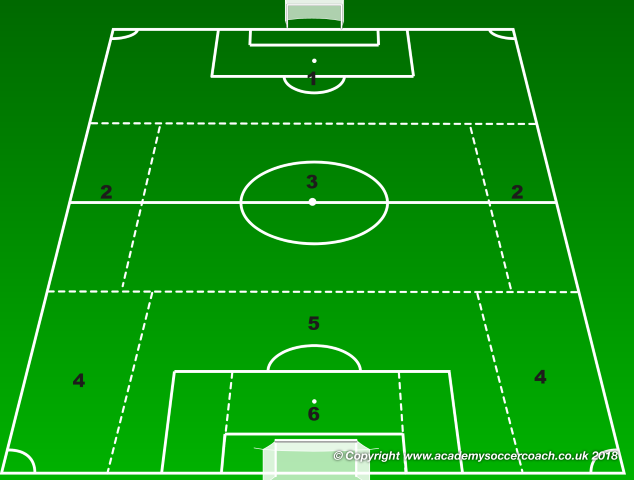
1) Team pressure to win the ball back, to keep the opposition away from the own goal with low risk.
2) Show the opposition strong zones, keep the opponent wide or show the center space if it's overload; prevent switches of play or the ball carrier from seeing the pitch.
3) Be compact to prevent forward passes or runs and be balanced to prevent counter-attacks. Force the possession phase toward zones 2 or 1.
4) Anticipate overloads, prevent cross passes or overlap runs and force the opposition backward. Track the opponents.
5) Patience and delay, pressure to force the opponents backward and avoid them turning. Compactness to prevent opposition passes in behind. Man mark is often required as well as retreating and recovering (tracking) the space, if the opposition is facing the goal.
6) Compactness to man mark the opponents, pressure to avoid any finishing chance and to clear the area.
From defense cooperation to team defense tactics
What is the defender's behavior according to the different areas of the field? How to work on the strategies in each area of the field? Is it better to code the behavior rules to be performed in each zone or to encourage experiences for the players to discover solutions?
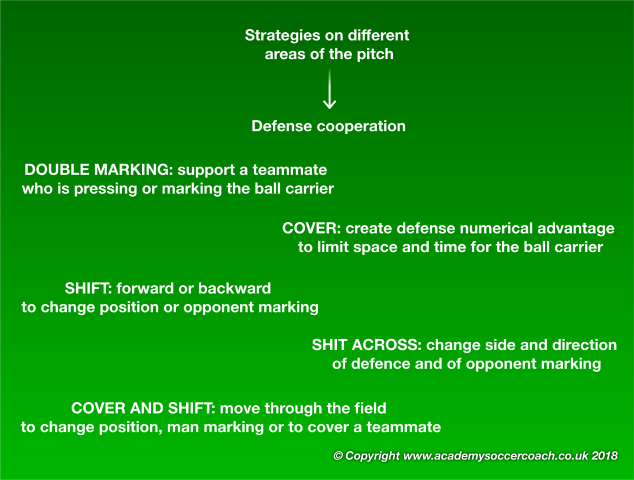
All these sectorial and inter-sectorial principles of play create defense cooperation pattern of play and shape the team transition to defend and the defense phases.
Group defense means coordinated and synchronized movements and strategies related to timing, lines and players distances of the defending team.
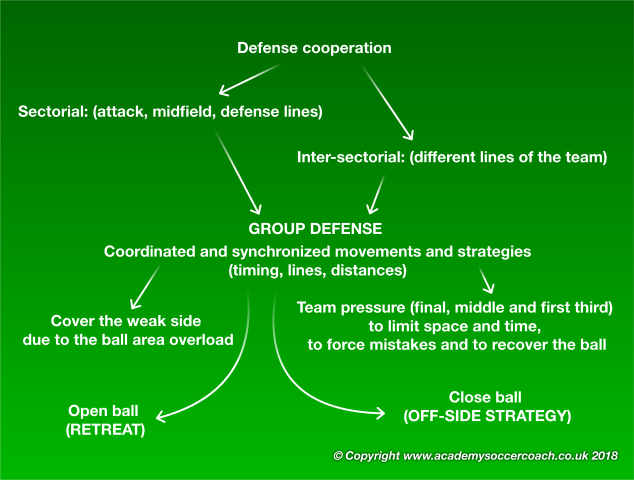
Cover the weak side:
• Prevention on the weak side due to the density near the ball area
• Sectorial and inter-sectorial organization and cooperation
• Synchronization of movements and timings related to the offside strategy
Pressure:
• Inside the first third in case of outnumbered situations
• Inside the middle third to look for counter-attacks chances
• Inside the final third to counter the build up phase of play of the opposition
When to press?
• Wrong ball control of the opponents
• Wrong body position of the opponent on the ball or of a potential receiver
• Wrong pass
• Wandering aerial balls
• Throw-ins
Offside strategy situations:
• Outnumbered defense situation
• "Easy reading" situation
• Goalkeeper, defense and midfield synchronization
• Zonal defending
• Player characteristics
The principles of play of the offside or retreat strategies:

Team tactics and system of play
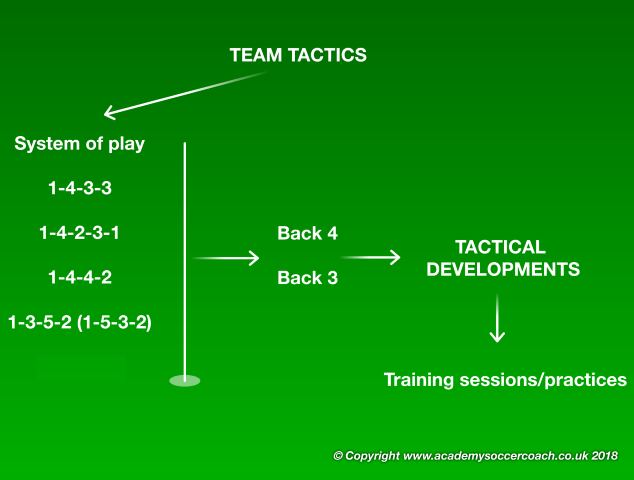
The defense tactics and the transition to defense phase too are influenced by the system of play and its tactical developments of a back 4, 3 or even 5 defense line. The individual principles of play are not strictly related to the systems of play and its developments because they are skills of the players that they can show whatever are roles and team's formations. We may say the same about the cooperation’s process among few players who are involved in a game situation, but just from sequential point of view. The game situation and its developments are now very important for the players' attitude and actions. Talking about sectorial, inter-sectorial and team tactics, where players from the same line, players of different lines, relations between the sectors are involved, the defense tactics are heavily influenced by the system of play and by the structural organization used by the team.
At this level, the structural organization becomes functional organization; it means that the system of play and the tactical ideas must be functional to create effective tactical developments. Relationships and interactions become very important; for this reason the system of play should help in creating these developments. The sectorial, inter-sectorial and team practices must be oriented toward this goal: create functional game situations where the tactical developments are related to the system of play and they fix the issue of the phases of play without the ball (transitions to defend and defense phase).


